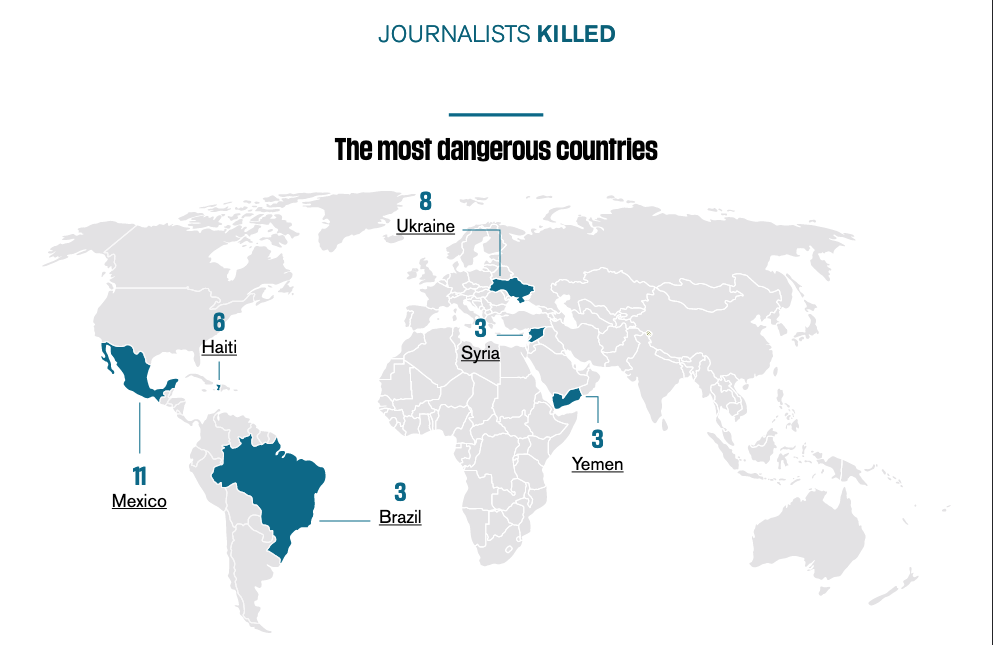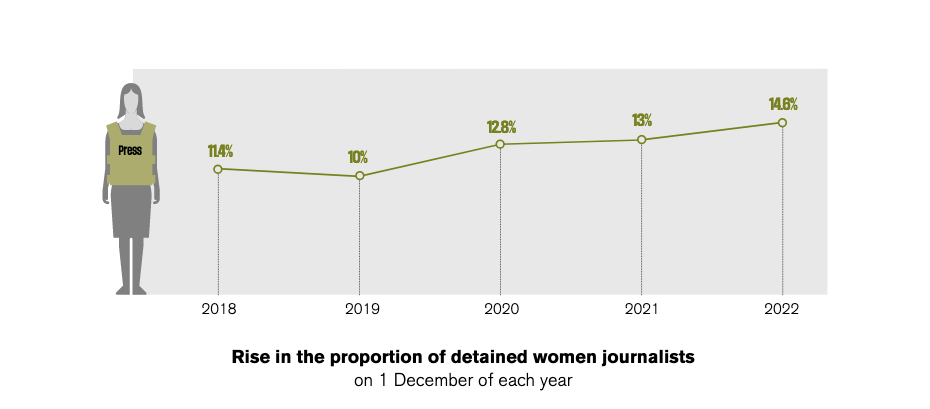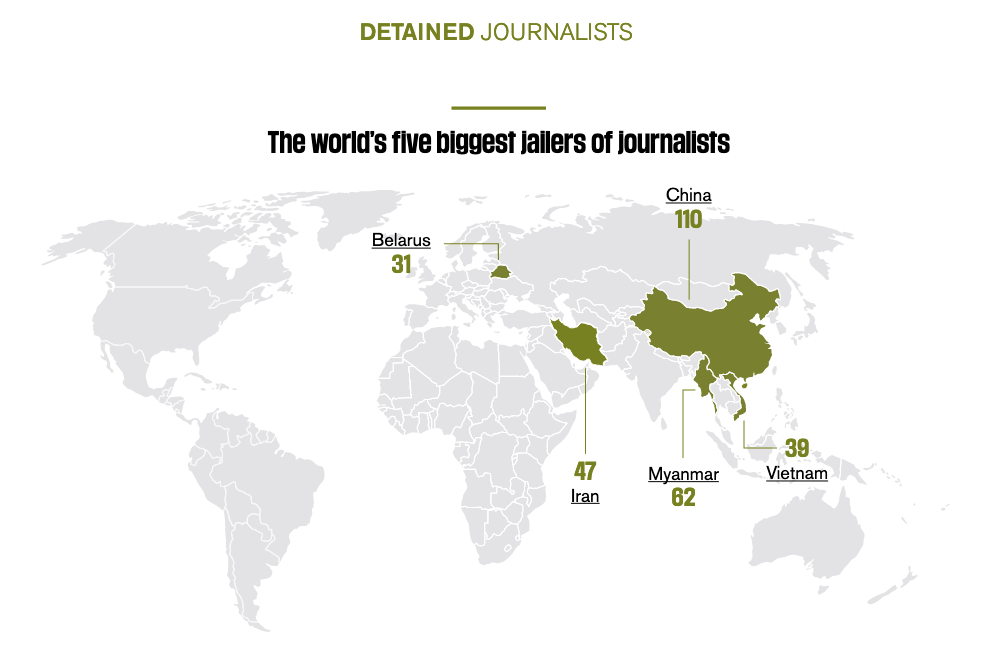
A new report by Reporters Without Borders (RSF) reveals an increase in the number of journalists killed and detained whilst doing their jobs in 2022, compared to the previous year.
The 2022 round-up report documents an all-time high 533 detentions of journalists (rising 13 per cent from last year) and 57 killings of journalists (rising 19 per cent from 2021). A further 65 journalists are being held hostage and there are two new cases of missing journalists.
The Ukraine war
The war in Ukraine, which broke out on 24 February 2022, is a significant cause for the increase in journalists killed.
Around a third of deaths happened in war zones (rising three percentage points) and deaths of journalists outside their home countries doubled. Of the eight journalists killed since the start of the war in Ukraine, five have been foreign reporters.

Screenshot RSF 2022 round-up report
Russia's invasion turned Ukraine into the world's second most dangerous country for the media. Standout cases include Maks Levin, a Ukrainian photojournalist who was deliberately shot by Russian soldiers on 13 March, according to the conclusions of an RSF investigation; and Frédéric Leclerc-Imhoff, who was hit by shrapnel from an exploding shell.
War zones became the riskiest stories to cover, resulting in more deaths of journalists than those investigating organised crime, corruption, protests and environmental issues.
Russia, on the other hand, has initiated a media crackdown since its invasion of Ukraine. Almost all independent media there have been banned, blocked and/or declared "foreign agents" in the course of the year.
Most of the journalists who stayed behind have been forced to work underground, as they could face as much as 15 years in prison for spreading "false information" about the Russian army. At least 18 journalists are currently imprisoned, including eight Ukrainian journalists who were arrested in Crimea, which was annexed in 2014 and is now subject to Russian law.
One of the two new cases of journalists gone missing is Dmytro Khiliuk (UNIAN, Ukraine), last seen in the then-Russian-occupied village, Dymer, back in March 2022.
The deadly continents
The other missing journalist in 2022 is Roberto Carlos Flores Mendoza, webpage editor of Chiapas Denuncia Ya, a site he founded to investigate authority abuse and citizen complaints in Mexico.
These two new cases bring the total of missing journalists up to 51 since 2000. Mexico alone accounts for 27 missing journalists, including the new case of Flores Mendoza.
Mexico is also the most dangerous country for journalists, accounting for a fifth of journalist killings in 2022 (four times more than its total last year). Journalist Lourdes Maldonado López was gunned down outside her home in January, one of four deaths in that month alone.
As a result, The Americas were the deadliest continent for journalists, with nearly half of the overall number killed worldwide and the highest number of journalists killed in 20 years, based on RSF’s data.

Screenshot RSF 2022 round-up report
Haiti, with six deaths, saw cases like that of Romelson Vilcin who was fatally wounded by police. Brazil, with three deaths, had the horrific case of Dom Phillips, a British journalist who was found dismembered in the Amazon rainforest.
The Middle East is the second deadliest region, where journalists continue to face multiple dangers in the Yemen civil war. Three journalists were killed in 2022 amid a growing climate of fear that discourages media reporting.
All of the 65 journalists being held hostage are in the Middle East except one, Olivier Dubois, a French journalist held hostage in Mali. More than a decade has passed since US journalist Austin Tice, presumed still alive, and British photojournalist John Cantlie, presumed dead, have been held hostage in Syria, the country with the most hostages (42). Local journalists still make up the majority (94 per cent) of hostages, with IS the leading hostage-taking organisation (28).
Worrying trends for women
Women still represent a minority of the deaths at 12 per cent, but a concerning trend is emerging: the number of women journalists killed in connection with their work has tripled in two years.
One stand-out case of 2022 was when Al Jazeera's reporter Shireen Abu Akleh was fatally shot while clearly marked as "Press" on her bulletproof vest while covering the Israeli-Palestinian conflict. Several independent investigations concluded that she was deliberately shot by the Israel Defence Forces, who deny culpability.
Another worrying trend for women is their number in prisons, with 78 women behind bars (up 28 per cent from last year). The report explains that "women are not spared from the repression faced by journalists. Like their male colleagues, they are victims of the regimes that are harshest towards press freedom."

Screenshot RSF 2022 round-up report
Four countries among those with the lowest rankings in RSF’s World Press Freedom Index detain more than 70 per cent of the world’s imprisoned women journalists – China (19), Iran (18), Myanmar (10) and Belarus (9).
China's 19 detained women include the high-profile cases of Zhang Zhan, winner of the 2021 RSF Press Freedom Prize, sentenced to four years in prison for "causing trouble" by covering the covid-19 pandemic on social media, and Huang Xueqin, an investigative journalist who documented sexual harassment of women and girls and covered stories involving corruption and industrial pollution. Xueqin has been held without trial for more than a year.
Iran is a deeply concerning country, where civil unrest has unfolded this year after the death of 22-year-old Mahsa Amini. The 18 arrests surrounding the protests paint a narrative of attempts to silence women. The two journalists who first drew attention to Amini's death, Nilufar Hamedi and Elahe Mohammadi, are now charged with "propaganda against the system and conspiring against national security," punishable by the death penalty.
Detained without trial
The 533 imprisoned journalists worldwide is a record high, rising 13 per cent in 2022. It has become a convenient method of censorship for authoritarian regimes.
Nearly two third are still being detained without trial and there are some shocking cases.
Cameroonian journalist Amadou Vamoulké has had a total of 137 hearings (57 in 2020 alone), without conviction. Now aged 72 and becoming increasingly unwell, he has spent more than 2,300 days in preventive detention.
China, a country where censorship and surveillance levels have become extreme, still leads the way with 110 imprisoned journalists. It is also the country with the most imprisoned journalists belonging to a single news organisation: Jimmy Lai, the founder of Hong Kong’s Apple Daily newspaper (which the authorities closed in 2020), and six members of his staff, are accused under the national security law of "conspiracy to collude with a foreign country or with external elements." All face the potential of life imprisonment.

Screenshot RSF 2022 round-up report
China is also waging a wider campaign of repression against the Turkic Muslim population in the Uyghur autonomous region of Xinjiang. Eight staff members of Uyghur Online are being held for unknown reasons, and the founder and award-winning journalist Ilham Tohti is serving a life sentence for "separatism".
The case of Julian Assange
Arguably the most famous detention case this year is that of Julian Assange. The Wikileaks founder has been charged with 18 counts in connection with publishing hundreds of thousands of leaked, classified documents that exposed information in the public interest. He is being held in the UK, with his mental and physical health under review. He is pending extradition to the US, and should that happen, he would face a total of 175 years in prison.
Free daily newsletter
If you like our news and feature articles, you can sign up to receive our free daily (Mon-Fri) email newsletter (mobile friendly).
Related articles
- RSF and NCTJ launch free online course for exiled journalists resettling in the UK
- 'Journalism is extraordinarily resilient in the face of pressure and change'
- The Journalism Trust Initiative is rewarding transparent and trustworthy news
- Economics woes affecting UK press freedom, RSF World Press Freedom Index finds
- Open letter calls for a change in response to online abuse of women journalists









